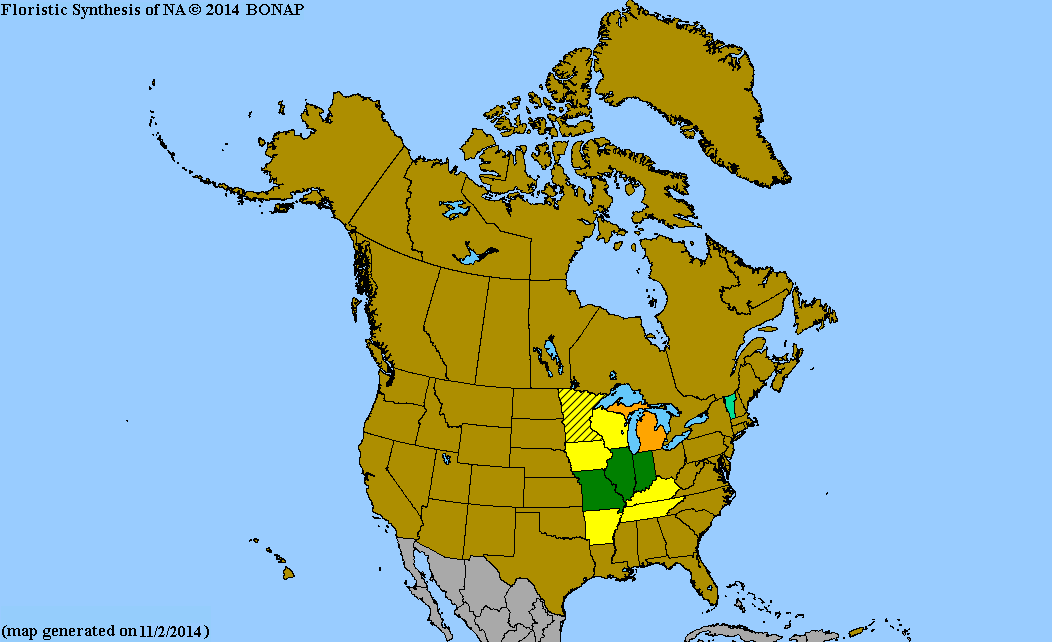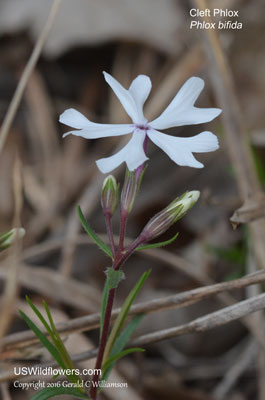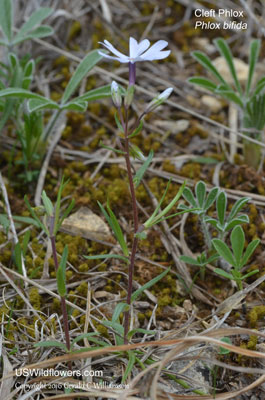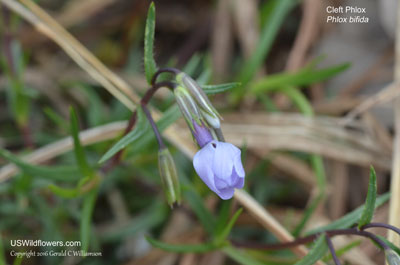Cleft Phlox, Glade Phlox, Ten-point Phlox, Sand Phlox, Starry Cleft Phlox - Phlox bifida
|
Phlox bifida - Cleft Phlox, Glade Phlox, Ten-point Phlox, Sand Phlox, Starry Cleft Phlox. The Phlox family - Polemoniaceae is primarily a family of the Americas with about 350 or so species. There are about 70 species in the Phlox genus. Phlox species can be very difficult to differentiate. Not only do several species share similar shapes in both the flower and the leaves, but the color ranges are broad and similar. You have to look at details to differentiate between many of the plants in this genus. Fortunately only a few have notably notched petals.
Phlox bifida is a species of the middle part of the United States, ranging from middle Tennessee and Kentucky west to Arkansas and Kansas, and north to Minnesota (1 county, not shown on the USDA map) and Michigan (where it might be extirpated.) It is reported to be established in the wild in 1 county in Vermont, where it is not native.
Found in:
AR, IA, IL, IN, KS, KY, MI, MN, MO, TN, VT, WI
Leave comments on Phlox bifida at this link. | 
Distribution of Phlox bifida in the United States and Canada:

Map courtesy of The Biota of North America Program.
Map color key
Search Our Database: Enter any portion of the Scientific, Common Name, or both.
Do a general Google search of the entire site:
#ad
 Follow USWildflowers on Twitter
| | Site: Couchville Cedar Glade, Davidson County, TN Date: 2016-March-30 | Photographer: Gerald C. Williamson
Nikon D7000
Tamron SP 90MM f/2.8 AF Macro | | The inflorescence of Phlox bifida is a small cyme of usually 3 flowers. The flowers are about 3/4 of an inch across. At the end of the long cylindrical corolla tube, each flower has 5 petal-like lobes which are white to pale blue or violet, and are deeply cleft. In subspecies stellata they are cleft to about 1/4 the length of the lobe, and in ssp. bifida they are cleft to about 1/2 the length of the lobe. (The petals of P. subulata are shallowly notched.) Phlox bifida is among the Phlox species with the anthers and style visible or very slightly exserted from the corolla tube. | | 
| | Site: Couchville Cedar Glade, Davidson County, TN Date: 2016-March-30 | Photographer: Gerald C Williamson
Nikon D7000 | | Phlox bifida is a moderately hairy plant, with hair on the calyx, pedicel, leaves (usually), and stem. Phlox bifida ssp. stellata has non-glandular hairs, while those of ssp. bifida are glandular. | | Click on the photo for a larger image

| | Site: Couchville Cedar Glade, Davidson County, TN Date: 2016-March-30 | Photographer: Gerald C Williamson
Nikon D7000 | | Phlox bifida rarely grows taller than about 12 inches. The stem of Cleft Phlox, which is typically a reddish green, is weak and may be decumbent or trailing. It is woody near the base, thus classifying the plant as a subshrub. The leaves are opposite as in most phlox, and are linear or very narrowly lanceolate. They are sessile to slightly clasping, and may be up to 2 inches long. The leaves are at the 4 or 5 nodes below the inflorescence; similar P. subulata (Moss Phlox) has more than 6 nodes, and the leaves are usually less than an inch long. | | Click on the photo for a larger image

| | Site: Couchville Cedar Glade, Davidson County, TN Date: 2016-March-30 | Photographer: Gerald C Williamson
Nikon D7000 | | The calyx of Phlox bifida is 5-lobed, with a hyaline membrane between the lobes. | | Click on the photo for a larger image

|
References used for identification and information:
|
|
| |
| #ad
|
|






